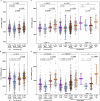Relationships of PGRN with sTREM2 in AD continuum and non-AD pathophysiology and their reciprocal roles in modulating amyloid pathology: two population-based study
- PMID: 40628712
- PMCID: PMC12238292
- DOI: 10.1038/s41398-025-03457-6
Relationships of PGRN with sTREM2 in AD continuum and non-AD pathophysiology and their reciprocal roles in modulating amyloid pathology: two population-based study
Abstract
Progranulin (PGRN) and soluble triggering receptor expressed on myeloid cells-2 (sTREM2) are emerging biomarkers of Alzheimer's disease (AD). This study explores the roles of their interplay in modulating amyloid pathology. We analyzed data from 905 participants (mean age = 62.0) in the CABLE cohort and 973 participants (mean age = 73.1) in the ADNI, classified using the A/T/N biomarker framework. One-way ANOVA was used to assess whether cerebrospinal fluid (CSF) PGRN and sTREM2 differed across biomarker profiles and clinical stages. Multiple linear regression models and linear mixed-effects models were used to test the relationships among PGRN, sTREM2, and CSF Aβ1-42 levels. Mediation analysis was used to explore the reciprocal relationships between sTREM2 and PGRN in influencing amyloid pathology. CSF proteomic and bioinformatic analyses were finally used to investigate the underlying biological mechanisms. In both cohorts, PGRN and sTREM2 were higher in individuals within the TN+ profile irrespective of the A status, and followed similar trajectory across different clinical and biomarker stage. CSF PGRN was associated with higher sTREM2 across AD continuum and non-AD pathophysiology. Bidirectional mediation was observed between PGRN (14.6% in CABLE, 15.6% in ADNI) and sTREM2 (29.7% in CABLE, 33.5% in ADNI) in modulating Aβ pathology (p < 0.0001). Proteomic analysis identified 1539 CSF proteins (Bonferroni-corrected p < 7.13 × 10-6) simultaneously associated with PGRN, sTREM2, and Aβ1-42. These proteins are mainly enriched in immune processes and neural plasticity. These findings suggest that the interplay between lysosome function and microglia-related neuroinflammation plays key roles in amyloid metabolism.
© 2025. The Author(s).
Conflict of interest statement
Competing interests: The authors declare no competing interests. Ethics approval and consent to participate: The CABLE and ADNI were approved by the institutional review boards of all participating centers, and written informed consent was obtained from all participants or authorized representatives according to the 1975 Declaration of Helsinki.
Figures




References
-
- Simon MJ, Logan T, DeVos SL, Di Paolo G. Lysosomal functions of progranulin and implications for treatment of frontotemporal dementia. Trends Cell Biol. 2023;33:324–39. 10.1016/j.tcb.2022.09.006. - PubMed
MeSH terms
Substances
Grants and funding
LinkOut - more resources
Full Text Sources
Medical
Miscellaneous

